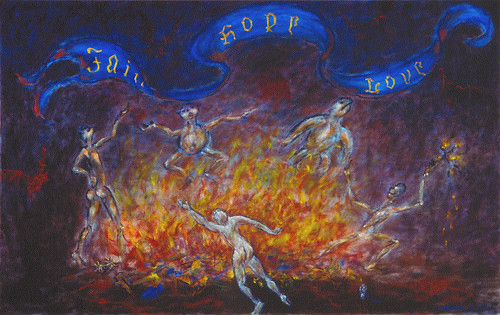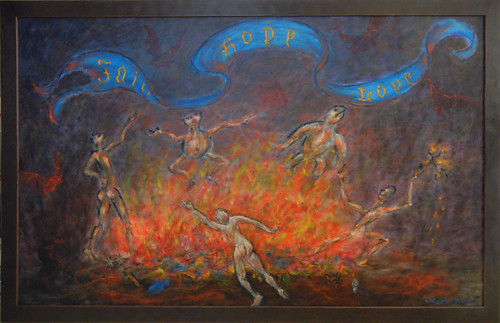Last month, a friend invited me to see her teenager son starring as Stanley Kowalski in the seminal American play, A Streetcar Named Desire, in his Oakland School for the Arts production. Since I've seen this amazing young actor and his school mates' performance before, I did not have much trepidation on their behalves. Even so, it was still quite ambitious for high school actors and their teacher to tackle this overtly emotional operatic piece.
Yet, I was gladly satisfied and quite moved by their performance - a performance was quite vivid, natural, honest and moving. If here or there one wished for a bit more display of emotion or chemistry, it was not the fault of their young age - those "shortcomings" could be as easily encountered in a full-fledged professional troupe. It was simply the challenge to portray the incredibly emotional and unstable characters, the challenge many adult and more experienced actors had often than not failed to wrestle to the ground. I also truly appreciated the rather understated, less melodramatic portrayals, a relief from common fault often seen in a Tennessee Williams' play. Most impressive was that those actors matched each other well, particularly amongst the well-balanced central quartet, with the appropriate focus on Blanche.
The young actors had pledged not to watch the famous film so as not to ape the inimitable Marlo Brando and Vivian Leigh, et al., therefore, breathed their and their teacher's own readings into these roles. I was particularly startled and impressed, positively, by the young actress' reading of that famous line of Blanche: "I don't want realism. I want magic!"
This line could be read many ways and here, her exclamation was a desperate attempt to stay afloat and a protestation against her foreseen doom. That contrasted greatly with another "A Streetcar Named Desire" I saw on stage in 1998, an operatic adaptation by San Francisco Opera, composed by André Previn, to the libretto (a condensation of the play) by Philip Littell, starring the American star soprano, Renée Fleming.
Previn's music for this operatic Streetcar was a meandering train wreck and I was terribly bored by the obvious musical and dramatic gestures provided by the composer and his diva. Previn constructed "I want magic" as a concert diva showpiece and when golden-voiced but always dramatically noncommittal Fleming sang it, it sounded like a willful five-year-old girl telling her mommy that she didn't want to know that Santa Claus is not real, that fairies do not exist. Rather, she "wants magic". It had neither fragility, tragedy, grandeur, doubt or delusion, therefore, a dramatic dead spot, and emotionally false, became a parody of a self-conscious diva prancing, however gracefully, in front of a gilded mirror.
Below is a segment of Fleming performing "I want magic!" in a concert and however lovely she sounded, it was dramatically false and even coy, from this lovely singer:
Related posts on Art · 文化 · Kunst:
- Theater Experiences in Wien (Vienna)
- Mark Rothko and "Red" at Berkeley Repertory Theatre
- Funny Theater, Not Textbook - David Henry Hwang's Chinglish at Berkeley Repertory Theatre
- Princess Turandot
- High Romanticism - German Tenor Jonas Kaufmann's Recital in Berkeley
- Angelic Voice - Philippe Jaroussky at Hertz Hall, UC Berkele
Tuesday, March 26, 2013
Saturday, March 23, 2013
Stringed White Dresses - The Process of a New Installation
Lately, I was inspired and several exciting ideas propelled me to work diligently to complete one installation last Friday. I documented the last stage of the process - painting background, wiring strings to the frames and final assembling, including the paper origami white dresses folded before. Below are several pictures and an edited, composite video of this final dash, all recorded on Friday, 22 March 2013:
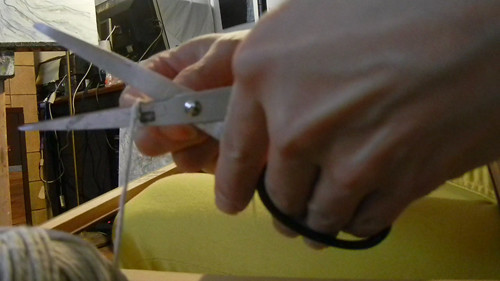
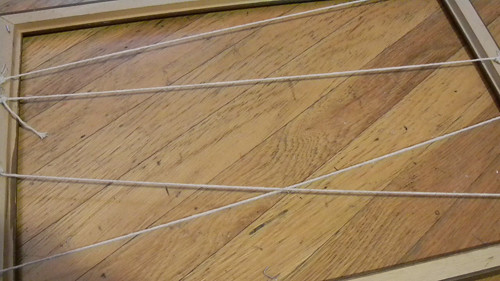
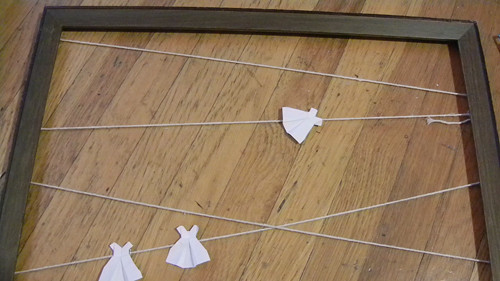
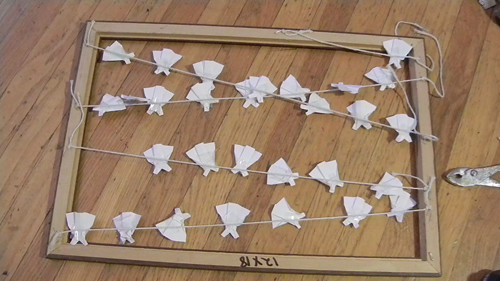
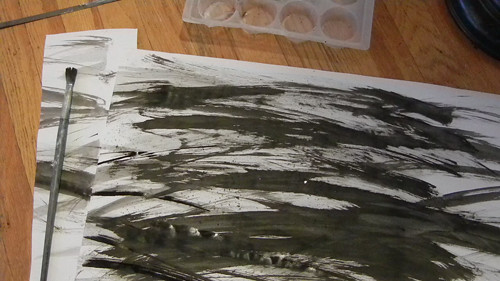
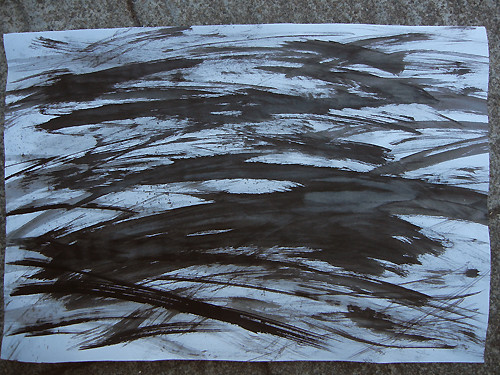
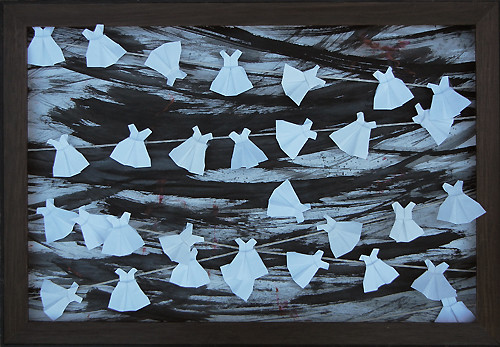
Stringed White Dresses - An Installation
Paper, Cotton Strings, Ink and Oil on Paper, Wooden Frames
20" x 14"
Related posts on Art · 文化 · Kunst:
- Unexpected Successes of "Stringed White Dresses - An Installation"
- Pomona Valley Review, Issue 7 Published with My Paintings and Installation
- Congregation - My New Art Installation
- A New Installation - Chairs Installation, November 2012 - Making Art With Mother in China
- Paper Boats, Chairs Installations and More







Stringed White Dresses - An Installation
Paper, Cotton Strings, Ink and Oil on Paper, Wooden Frames
20" x 14"
Related posts on Art · 文化 · Kunst:
- Unexpected Successes of "Stringed White Dresses - An Installation"
- Pomona Valley Review, Issue 7 Published with My Paintings and Installation
- Congregation - My New Art Installation
- A New Installation - Chairs Installation, November 2012 - Making Art With Mother in China
- Paper Boats, Chairs Installations and More
Labels:
Art,
Installation,
My Installation,
Origami,
Process,
White Dress
Wednesday, March 20, 2013
Famed Terracotta Warriors and Their Intriguing Successors
San Francisco Asian Art Museum is parading a small formation of eight famed terracotta warriors and two horses from the mausoleum of Qin Dynasty's first emperor, Qin Shihuang (259-210 BCE), in Xi'an, China. The eight warriors are the the maximum number allowed to travel here en bloc and in this museum, it formed the core of the special exhibit "China's Terracotta Warriors: The First Emperor's Legacy" (February 22 - May 27).
Eight warriors can hardly represent the massive underground armies the crazed emperor assembled but they at least can provide a passing glimpse of that awesome and fearful spectacle. Asian Art Museum informed us:
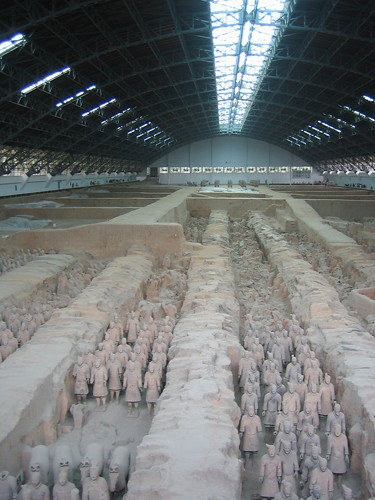
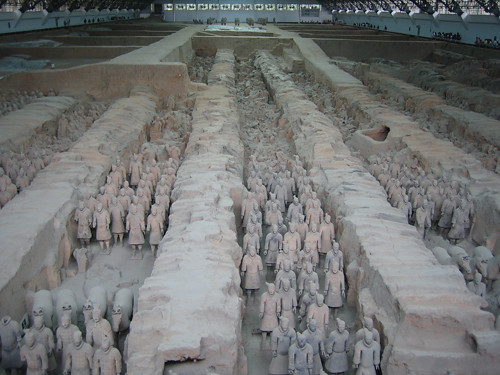


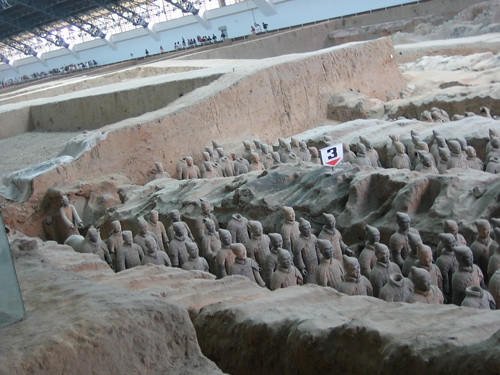
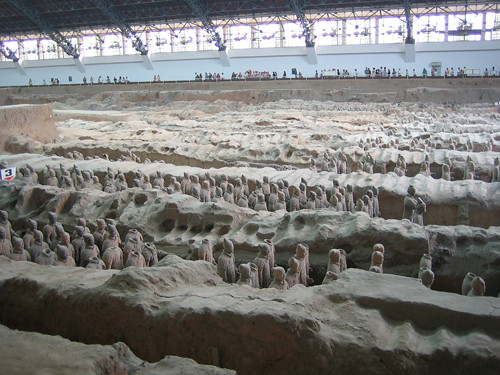
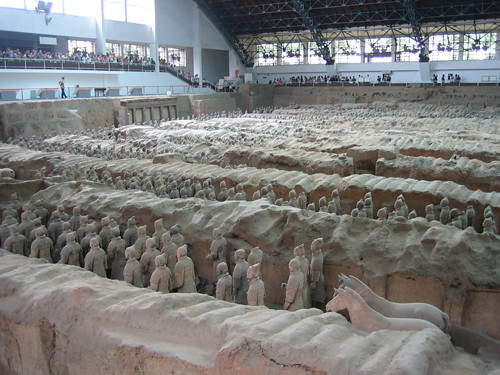
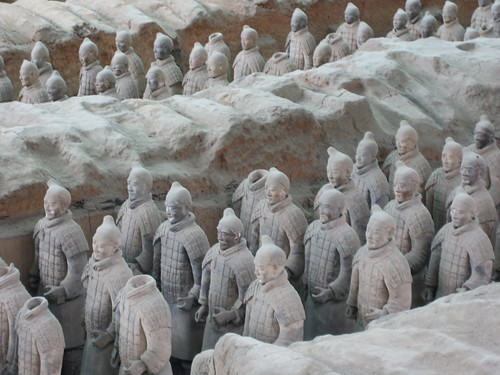
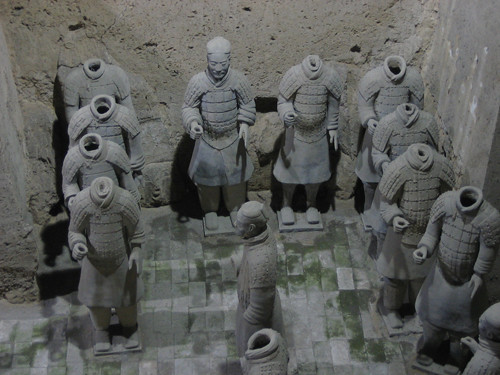
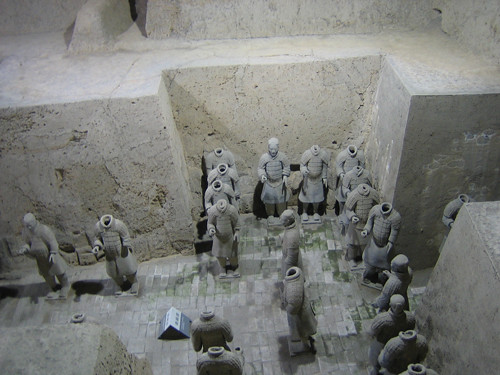
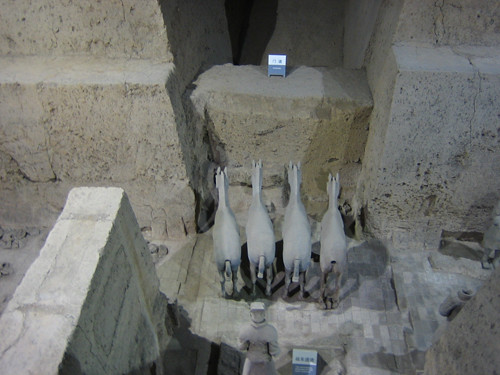
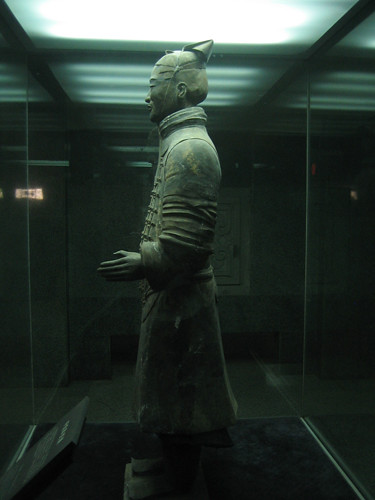
Despite that I have seen them in situ, I still plan to visit Asian Art Museum and for those who haven't seen them in Xi'an, I strongly encourage you to take the advantage of inspecting them up and close, more so than you could do in Xi'an.
The mausoleum in Xi'an was amazing yet it was topped a few days later in Xianyang, a smaller city nearby, in the same Shaanxi Province. There, I visited the mausoleum of an emperor from the next dynasty, Han, Emperor Jing of Han (188 BC – 141 BC).
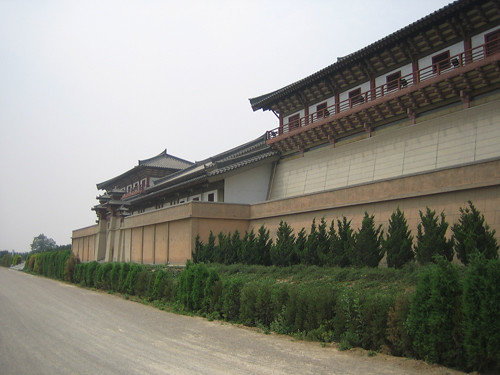
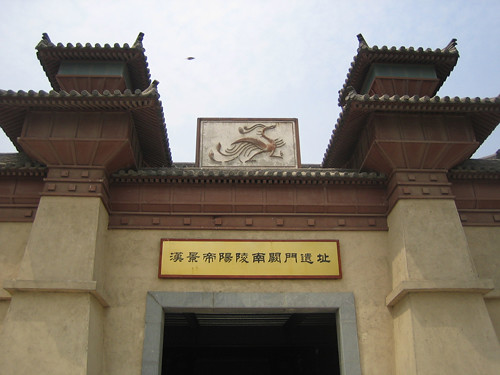
Either because Han Dynasty was less prosperous due to long drawn-out wars, or its emperors were less megalomaniac, none of its emperors' tombs or mausoleum match the scale of the "First Emperor's". Even the underground guards were not really warriors and war horses, but court personnel and domesticated animals, and in a much reduced scales, about 1/3 or 1/4 of the real size, as seen in Emperor Jing's mausoleum in Xianyang. Emperor Jing of Han was an important figure in Chinese history. Wikipedia described his thus:
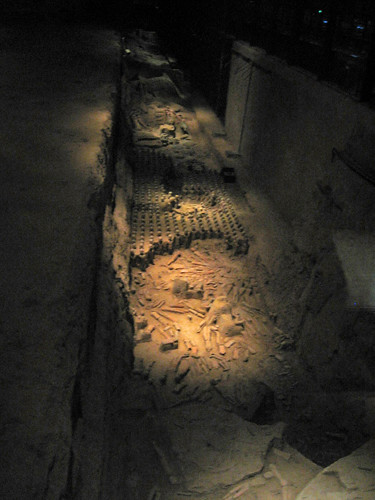
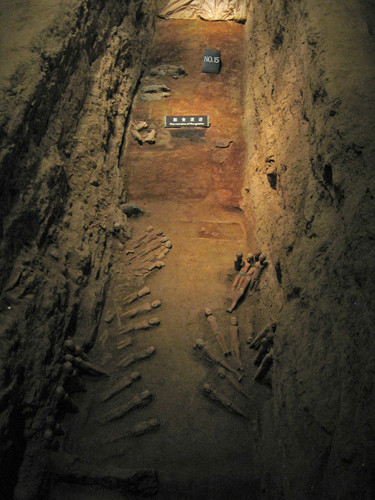
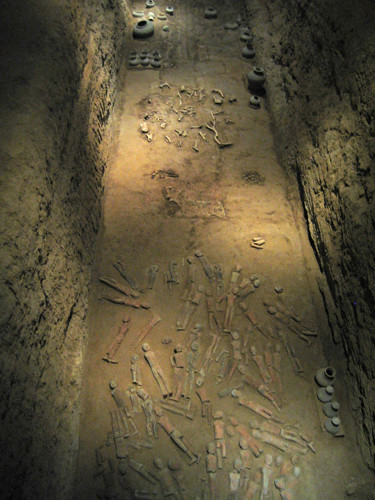
We were also able to see some of those figurines and animals in display cases with better lighting. Those doll figurines had earthenware torsos and their wooden arms had rotten away, made them rather creepy, and I praised them over the full-sized terracotta warriors for the exoticism emitted from these mutilated figurines below:
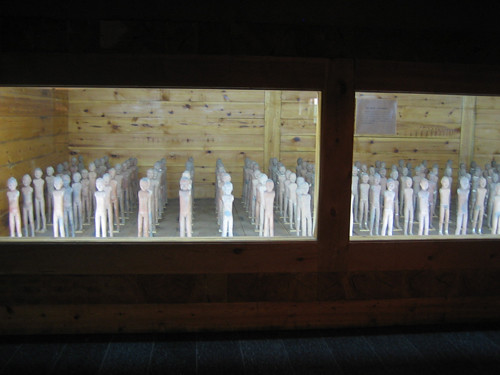
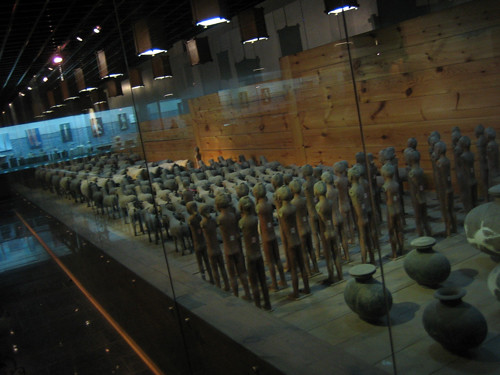
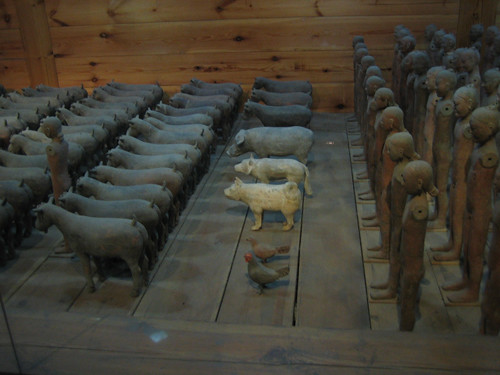
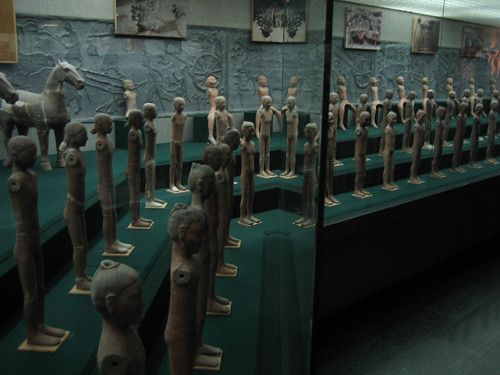
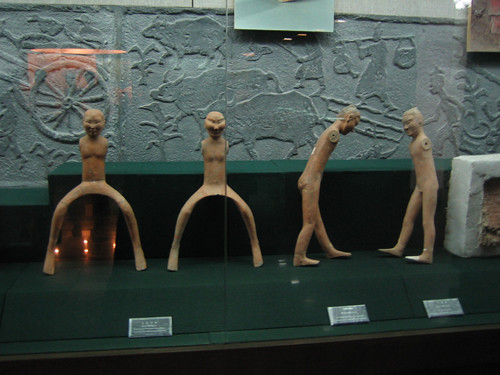
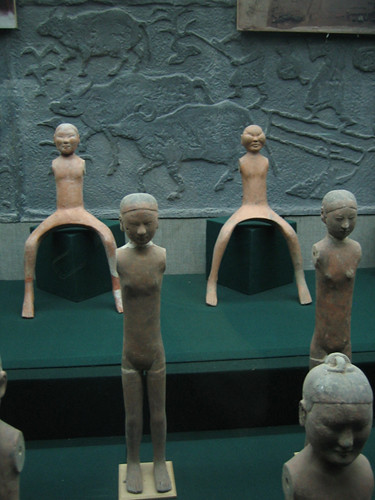
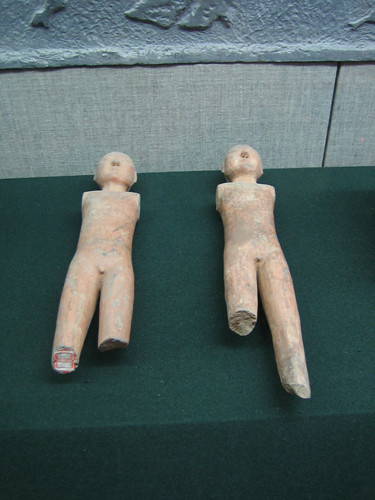
Related posts on Art · 文化 · Kunst:
- Last Chance to See Terracotta Warriors in San Francisco Asian Art Museum
- Weep for Ancient City Walls of Xi'an
- Ruins in Sanxingdui (Three-Star Mound) and Jinsha (Gold Sands), Sichuan, China
Eight warriors can hardly represent the massive underground armies the crazed emperor assembled but they at least can provide a passing glimpse of that awesome and fearful spectacle. Asian Art Museum informed us:
Imperial leader. Fearsome tyrant. Military genius. Avid anti-intellectual. Obsessive star-gazer. Enduring mystery. The First Emperor, Qin Shihuang (259-210 BCE) was all these things and more. His storied legacy is rich with enduring achievements, including the unification of China under centralized imperial rule, brilliant military systems and advanced engineering and assembly production. He is also reputed to have burned scores of books, buried scholars alive and achieved widespread domination through devastating bloodshed.Bear in mind that the excavation sites and the half-buried warriors, horses, and chariots in Xi'an are only a portion of the vast mausoleum site, whose full extent has not been fully mapped out. In 2007, I had the chance to visit the excavation site and those on display were truly astonishing, in their sheer numbers and the refinement and individuality of those warriors and horses, obviously modeled after real living creatures. They were also painted yet almost completely fainted with only traces of pigments remained, just like those ancient Greek marbles, and more satisfyingly beautiful to me. Below are sample pictures I took during that trip:
First unearthed in 1974, the underground burial complex of the First Emperor is a revelation for the ages, an astonishing discovery on par with Egypt’s mummies and elaborate tombs. Contemporary observers continue to be enthralled by his legacy, and it is through this ongoing interest that the First Emperor did indeed achieve immortality. This exhibition includes ten figures—a representative sample of the actual army, which is estimated to include more than 7,000 life-sized figures and over 10,000 weapons.












Despite that I have seen them in situ, I still plan to visit Asian Art Museum and for those who haven't seen them in Xi'an, I strongly encourage you to take the advantage of inspecting them up and close, more so than you could do in Xi'an.
The mausoleum in Xi'an was amazing yet it was topped a few days later in Xianyang, a smaller city nearby, in the same Shaanxi Province. There, I visited the mausoleum of an emperor from the next dynasty, Han, Emperor Jing of Han (188 BC – 141 BC).


Either because Han Dynasty was less prosperous due to long drawn-out wars, or its emperors were less megalomaniac, none of its emperors' tombs or mausoleum match the scale of the "First Emperor's". Even the underground guards were not really warriors and war horses, but court personnel and domesticated animals, and in a much reduced scales, about 1/3 or 1/4 of the real size, as seen in Emperor Jing's mausoleum in Xianyang. Emperor Jing of Han was an important figure in Chinese history. Wikipedia described his thus:
Emperor Jing of Han (188 BC – 141 BC) was an emperor of China in the Han Dynasty from 156 BC to 141 BC. His reign saw the limit and curtailment of power of feudal princes which resulted in the Rebellion of the Seven States in 154 BC. Emperor Jing managed to crush the revolt and princes were thereafter denied rights to appoint ministers for their fief. This move consolidated central power which paved the way for the glorious and long reign of his son Emperor Wu of Han.Once again, the excavated site was only a small portion of the whole burial ground. Even so, it was impressively huge, with numerous small doll figurines half-buried. Visitors were allowed to walk along transparent walkways and inspect those artifacts, as undisturbed as possible.



We were also able to see some of those figurines and animals in display cases with better lighting. Those doll figurines had earthenware torsos and their wooden arms had rotten away, made them rather creepy, and I praised them over the full-sized terracotta warriors for the exoticism emitted from these mutilated figurines below:







Related posts on Art · 文化 · Kunst:
- Last Chance to See Terracotta Warriors in San Francisco Asian Art Museum
- Weep for Ancient City Walls of Xi'an
- Ruins in Sanxingdui (Three-Star Mound) and Jinsha (Gold Sands), Sichuan, China
Sunday, March 17, 2013
Before and After - A Painting Framed
Once in a long while, I would be ready to fork out some money to have one of my paintings framed professionally. Framing a painting is no trivial matter - it requests no trivial amount of money, and it requests serious deliberation on choosing the right ones. A painting is like a person, whose look and impression can morph drastically with the clothes. Clothes can flatter or debase a person and a frame can do the same to a painting.
My philosophy regarding frames is to do no harm. The frames are to harmonize with the work but not to take the viewer's attention away from the piece, unless we want to hide some defects, imaginary or real, from the viewers. I generally stay away from too ornate and heavy frames, which often dwarf the relatively small pieces we produce in the modern days, for modest settings. Simple, in tune, and improve subtly.
Below is the painting I just took back from a framer. Though the snap shot of the framed work does not quite match, color wise, the professionally done photo, one can still see the effect of this set of frames:
Other Related posts on Art · 文化 · Kunst:
- New Presentations of My Yearly Artworks
- First Painting Completed in 2013
- Unexpected Successes of "Stringed White Dresses - An Installation"
- "White Dress" Series Continues - A New Drawing and a New Painting
- 2012 Recapitulation - Video Presentation of Paintings Completed in 2012
- Revolutionary Way to Shop for Clothes. What About Frames?
- Baby's New Clothes
My philosophy regarding frames is to do no harm. The frames are to harmonize with the work but not to take the viewer's attention away from the piece, unless we want to hide some defects, imaginary or real, from the viewers. I generally stay away from too ornate and heavy frames, which often dwarf the relatively small pieces we produce in the modern days, for modest settings. Simple, in tune, and improve subtly.
Below is the painting I just took back from a framer. Though the snap shot of the framed work does not quite match, color wise, the professionally done photo, one can still see the effect of this set of frames:
Other Related posts on Art · 文化 · Kunst:
- New Presentations of My Yearly Artworks
- First Painting Completed in 2013
- Unexpected Successes of "Stringed White Dresses - An Installation"
- "White Dress" Series Continues - A New Drawing and a New Painting
- 2012 Recapitulation - Video Presentation of Paintings Completed in 2012
- Revolutionary Way to Shop for Clothes. What About Frames?
- Baby's New Clothes
Labels:
Frame,
My Painting
Thursday, March 14, 2013
Beautiful Spring Time
Though the evening chill still visits us time to time, it is definitely spring time in Berkeley, California now. I'm utterly enchanted by the blooms everywhere - yellow, white, pink and red, etc.
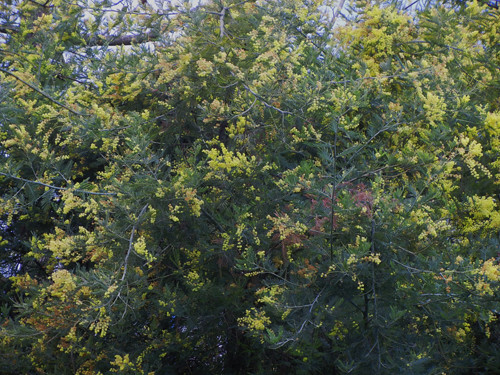

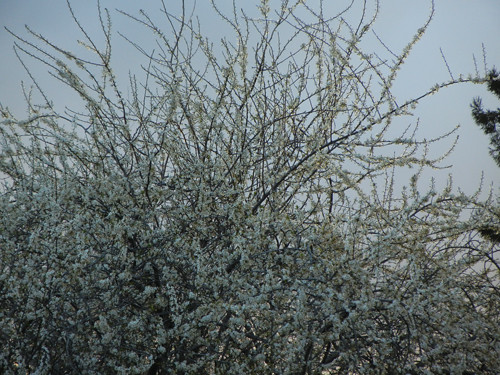
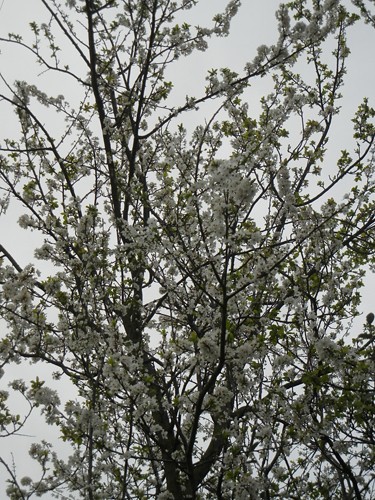
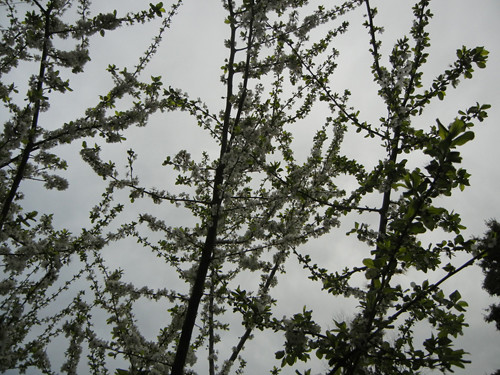
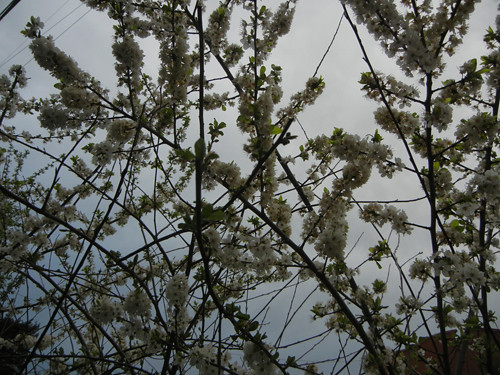
The few white blooms above were shot in a somewhat foggy day but even so, the sense of spring was palpable. Of course, even in spring time, there will be storms and storms and clouds can be beautiful, even in the forbidding urban setting like the two snap shots below:
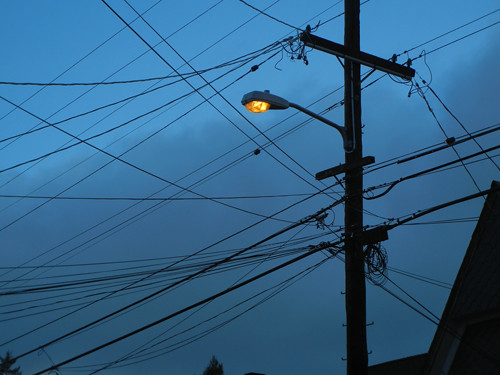
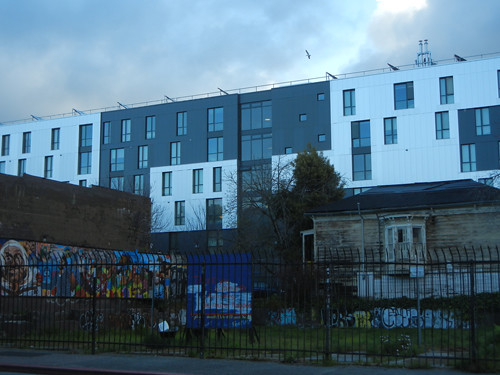
Since I'm back to the urban landscape from nature, I'll include two more pictures from the Berkeley Art Museum, though industrial looking, the soft lighting echoed the spring outside the concrete walls.
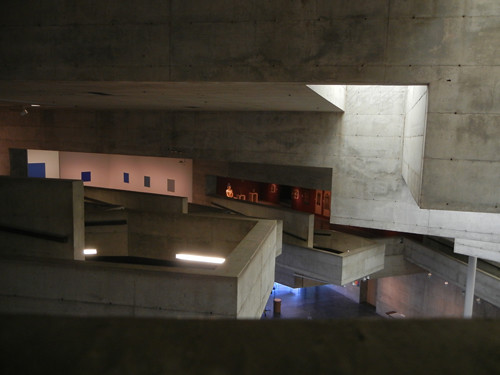
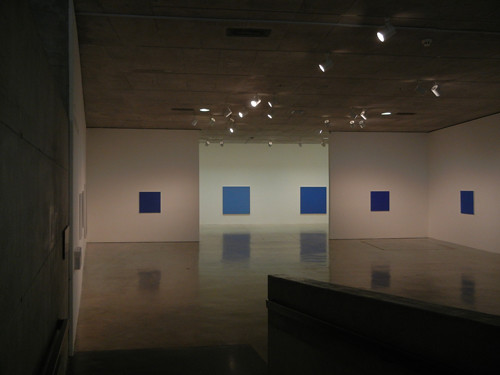
Finally, below picture was a picnic I had last weekend, with my friends from my book group. Marvelous luncheon.
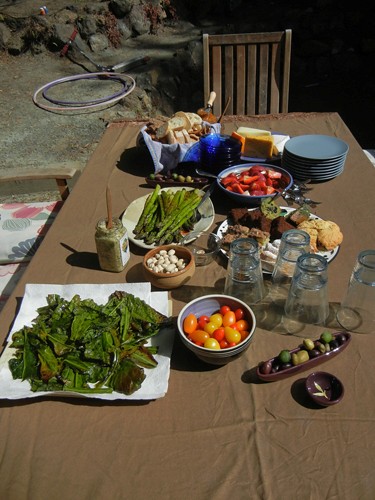






The few white blooms above were shot in a somewhat foggy day but even so, the sense of spring was palpable. Of course, even in spring time, there will be storms and storms and clouds can be beautiful, even in the forbidding urban setting like the two snap shots below:


Since I'm back to the urban landscape from nature, I'll include two more pictures from the Berkeley Art Museum, though industrial looking, the soft lighting echoed the spring outside the concrete walls.


Finally, below picture was a picnic I had last weekend, with my friends from my book group. Marvelous luncheon.

Tuesday, March 12, 2013
Video Presentation of Oil Painting "Black Woods"
Time to time, I feel the impulse to focus on a particular painting, to tell my viewers what was the story behind, such as "Progression", "Dissonance", "Liberation Road" and "The Song of Orpheus", all of them I had made video presentations to give views of these works from multiple angles.
"Black Woods" video below, however, demonstrated the progress of this semi-representational and I hope that seeing the process of layers of upon applied upon layers prove interesting, at least not boring for my viewers.
Video Presentation of Black Woods (2010):
>> Video presentations of paintings and drawings, Part XXIX: 2003 Recapitulations - Video Presentation of Paintings
<< Video presentations of paintings and drawings, Part XXVII: 2004-05 Recapitulations - Video Presentation of Paintings
List of Video Presentation of My Artworks
"Black Woods" video below, however, demonstrated the progress of this semi-representational and I hope that seeing the process of layers of upon applied upon layers prove interesting, at least not boring for my viewers.
Video Presentation of Black Woods (2010):
>> Video presentations of paintings and drawings, Part XXIX: 2003 Recapitulations - Video Presentation of Paintings
<< Video presentations of paintings and drawings, Part XXVII: 2004-05 Recapitulations - Video Presentation of Paintings
List of Video Presentation of My Artworks
Labels:
My Painting,
My Video
Saturday, March 9, 2013
The Wacko People's Republic of China
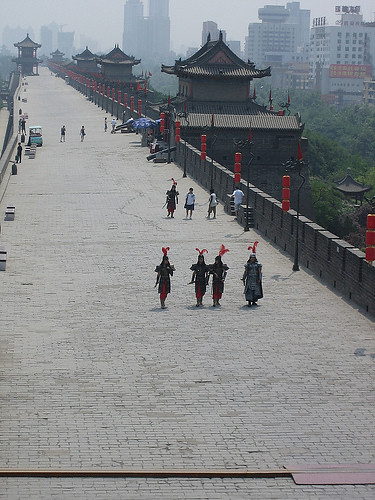
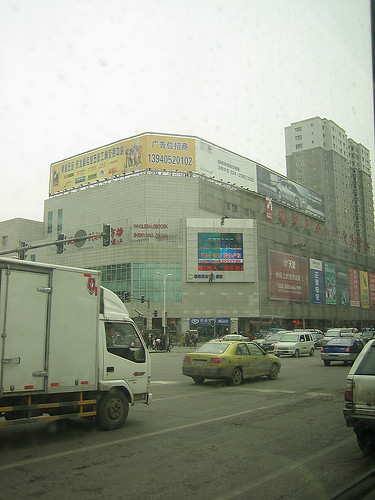
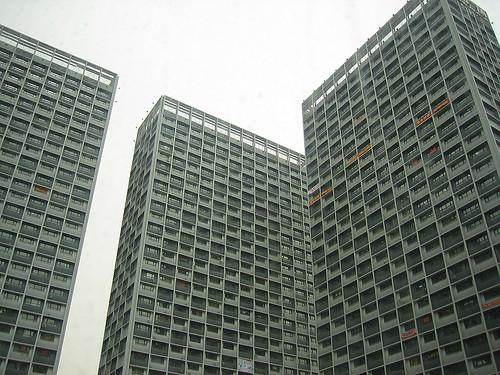
There are a spate strange stories came from China or about China recently and I start to wonder if the official name of that country ought to change from The People's Republic of China to The Wacko People's Republic of China.
Last year, Chinese Communist Party had a new Secretary General and new crop of Politburo and now they are having the so called "Two Conferences" (两会) - The National People's Congress and The National People's Political Consultation Conference - the rubber-stamping parliament and a broader-based conference, designed for selected people to vent a little and to show support to the (Communist) Party.
These Conferences change their members every five years and within those five years periods, the members meet a couple weeks a year, receiving the government report from the Prime Minister and State Council, and duly approve it, plus other bills miraculously appeared to be duly approved.
The Representatives of the Congress and the Consultants are picked and duly "elected" from all sectors to represent their fields, and not to leave their jobs as athletes, actors, merchants, clerks, farmers, soldiers and officials, etc., therefore more or less guaranteed that those Representatives would not be able to have true grasp of politics and policies and at the best they could throw out some harmless bills, whose chances of becoming laws are nil.
One of such Representatives, SHEN Jilan (申纪兰), of farmer origin, in recent years has attracted much attention by being the only person who had been a Representative since the first congress in 1954 through now, and the only person who had always cast yeses in all 12 congresses (many others only votes yes but not in all of the conferences), and her fantastic speeches and commentaries.
In 2010, she pronounced: "I support the Communist Party very much. Being a representative is to listen to the party, [therefore] I have never voted no (“我非常拥护共产党。当代表就是要听党的话,我从来没有投过反对票)." - [source: “最老”人大代表申纪兰:55年从没投过反对票]
She does not use internet and does seem to understand internet much, though not without opinions. She said that
I have an idea, someone should supervise the internet and it cannot be used by anyone at will, just like the People's Daily. Foreigners' blindly tampering with internet, and we cannot do it that way; we are to have principles, and should turn good things bad; and we should not say whatever we think - we are the socialist country under the leadership of the Communist Party. (我有个想法,网也应该有人管,不是谁想弄就能弄,就跟人民日报一样,外国那些人那是瞎弄的,咱不能这样,咱要按照原则去弄,不要好的弄成坏的了,想说什么就说什么,咱是共产党领导下的社会主义国家。)Continuing on the internet issue, she said that "on this network, can anyone who wants to use it use it? Or is it to be approved by establishments? (这个网,你谁想上就能上?还是要组织批准呢? )"
She believed that during the Representative's selection process, it is improper for the Representatives to interact with voters. She said that "we have democratic elections. I do not interact with voters." (人大代表在选举过程中与选民交流不合适,“我们是民主选举 我不跟选民交流。) - [source: 申纪兰:要给人民办事才能当人民代表. 中国网. 2012]
If Shen's speeches were ridiculous, opinions and bills from others seems to aim at becoming the most entertaining and outrageous.
A Consultant, Ms. NI Ping, an entertainer, was asked once if she had ever voted no and she answered that she had never voted no or abstain from voting, because "I (considered) national interests, I love this country. Principles of her participation of politics was not to add trouble. (因为“我是(考虑)国家利益的,我热爱这个国家”。她的议政原则是“不添乱”。)
A Representative to the Congress, ZHU Lieyu (朱列玉), proposed to reduce the punishment of embezzlement of more than 100,000 Yuan from 10 years and above to 1 year and above. Inflation concern?
Another Consultant, CHEN Guangbiao (陈光标), claimed that the Family Planning Policy should change. People who do not have 9 years' education ought not to have children. People who had studied in high school can have one child, and people have higher education could have unlimited number of children.
Another Representative, ZHOU Sen (周森), Vice president of the China Charity Federation, proposed that "every citizen must donated a portion of wages for charity (每一位公民必须从工资捐出一部分用于慈善)”。
The last comment reminded me to the story took place in the US. "A 19 year old Chinese national who faces a vehicular-homicide charge for a Nov. 10 accident that left one woman dead and three injured in Des Moines has been freed on bail after his family posted a $2 million cashier’s check." According to Seattle Times, "During a bail hearing Friday, Xu’s mother produced a cashier’s check for the total amount, said Ian Goodhew, deputy chief of staff for the King County Prosecuting Attorney’s Office. Once the funds were verified by the county jail, he was released at 8 that night. 'Rarely is a bail of that amount posted,' Goodhew said."
China reached its glaring income inequality in a remarkably short time and their government approved charities are practically without accountability and could easily become someone's private wallets. The report from Bloomberg a year ago revealed the depth of wealth inequality, which only gets worse:
The richest 70 members of China’s legislature added more to their wealth last year than the combined net worth of all 535 members of the U.S. Congress, the president and his Cabinet, and the nine Supreme Court justices.The wackiness of China does not remain within its border. The death of the president of Venezuela Hugo Chavez has been blamed on the US by certain sectors but if that accusation has not been taken seriously by many people, it has been reported in China by its largest newspapers with straight face.
The net worth of the 70 richest delegates in China’s National People’s Congress, which opens its annual session on March 5, rose to 565.8 billion yuan ($89.8 billion) in 2011, a gain of $11.5 billion from 2010, according to figures from the Hurun Report, which tracks the country’s wealthy. That compares to the $7.5 billion net worth of all 660 top officials in the three branches of the U.S. government.
The income gain by NPC members reflects the imbalances in economic growth in China, where per capita annual income in 2010 was $2,425, less than in Belarus and a fraction of the $37,527 in the U.S. The disparity points to the challenges that China’s new generation of leaders, to be named this year, faces in countering a rise in social unrest fueled by illegal land grabs and corruption.
NBC News reported this accusation as this:
Hours before Venezuelan President Hugo Chavez died, his second-in-command accused enemies of giving him cancer and announced the expulsion of two U.S. diplomats for an alleged plot to destabilize the government.
"There's no doubt that Commandante Chavez's health came under attack by the enemy," Vice President Nicolas Maduro said in an address to the nation from the presidential palace.
State Department spokesman Patrick Ventrell said in a statement it was "absurd" to suggest that the U.S. was somehow involved in Chavez's illness.
Chinese media also took the opportunity of the resignation of Pope Benedict to educate Chinese on the issue of churches and the Catholic Church in particular.
An article appeared on The Global Times, the leading Maoist newspaper, told the readers that Vatican was the only European country had no formal diplomatic relationship with China. It said that in 1952, China suspended all official relations with the Vatican, and banned the Catholic Church (中国中断了与梵蒂冈所有官方关系,取缔了天主教堂). "Chinese Catholic Patriotic Association" was founded in 1958. "Chinese Catholic Bishops College, established in 1982, is the head of the Chinese Catholic parish. (“中国天主教爱国会”于1958年成立。1982年组建“中国天主教主教团”,为中国天主教各教区的领导机构。)
The article emphasized on the independence of Chinese Catholic Church. It continued with a question and "answer":
Some people may ask: Does Chinese church have autonomy? Yes, of course. Anglicanism is the obvious example... King of England named himself the supreme leader of the church. So far, Britain's Queen Elizabeth II retains the title of "Christian protector". (有人会问:中国有办理教会的自主权吗?当然可以。英国国教就是明显例证... 英国国王把自己封为教会的最高领导人。迄今,英国女王伊丽莎白二世还保留着“基督教保护者”头衔。)Naturally, they made no difference between Roman Catholic Church and the Church of England and those people are the ones claim that the twenty-first century is the Chinese Century.
Global warming? I'm shuddering.
Thursday, March 7, 2013
2004-05 Recapitulations - Video Presentation of Paintings
My watershed year was 2003, when I started my Apocalypse Series of paintings and drawings, when the US was poised to invade Iraq and I made several dark paintings such as "The Triumph of Saint George".
In 2004 and 2005, I continued my effort but 2004 was an obvious recovering year, from deep emotions and 2005 was the year I tried to function as a "normal" person, less disturbed and angry. My works were less disturbing and less controversial, with more resigned sadness:
2004:
2005:
>> Video presentations of paintings and drawings, Part XXVIII: Video Presentation of Oil Painting "Black Woods"
In 2004 and 2005, I continued my effort but 2004 was an obvious recovering year, from deep emotions and 2005 was the year I tried to function as a "normal" person, less disturbed and angry. My works were less disturbing and less controversial, with more resigned sadness:
2004:
www.flickr.com
|
2005:
www.flickr.com
|
>> Video presentations of paintings and drawings, Part XXVIII: Video Presentation of Oil Painting "Black Woods"
<< Video presentations of paintings and drawings, Part XXVI: 2006-08 Recapitulations - Video Presentation of Paintings
Labels:
2004,
2005,
My paintings,
My Video,
Recapitulation
Tuesday, March 5, 2013
Late Night of Jewish Museum in Vienna
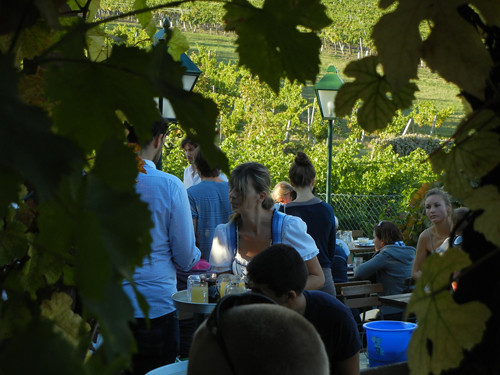 |
| Heurige Weingut, Kahlenberger Straße, between Kahlenberg and Nußdorf |

Großer Saal, Musikverein
After the concert and a wonderful Italian dinner near the Staatsoper, we decided to continue our long day, with our gracious hosts, to one of those 120 museums - Jüdisches Museum (Jewish Museum)
Many museums were quite crowded, such as this Schmetterlinghaus (Butterfly House) at Hofburg below:
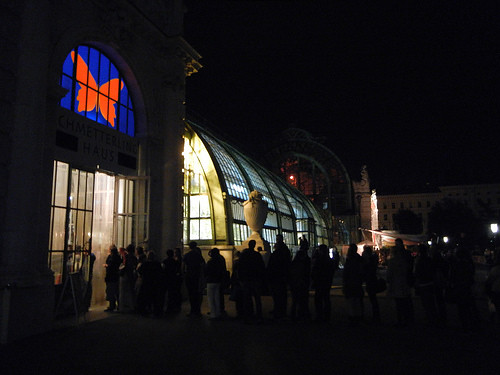
Schmetterlinghaus
Mercifully, the Jewish Museum was less crowded though hardly deserted. This museum was not very big, had a mixture of artifacts recording Jewish people's daily life and religious services in Vienna and Austria - Vienna and the World: The Jewish Museum Visible Storage, a collection of contemporary art by Jewish artist or on Jewish theme, and a special exhibit “Vienna. Jewish Museum. 21st Century”.
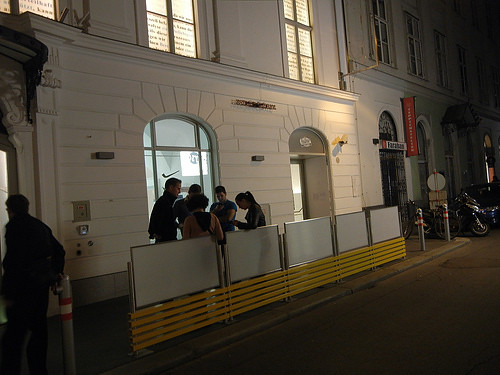
All the exhibitions in the modest-sized museums were fascinating, particularly those family records and writings - letters, diaries, etc. were of great interest; no precious metals and stones could compete with them for the sediment of history those records had accumulated through tears, sweats, and blood. But this is not mean to slight the amazing artifacts collected there - from solemn to witty, from humble to haunting, all steeped in enviable long tradition and manifested incredible beauty. To the museum's credit, they also displayed some artifacts demonstrated prejudice against Jewish people in the region and served as a somber reminder of the ugly past took place in this beautiful land.
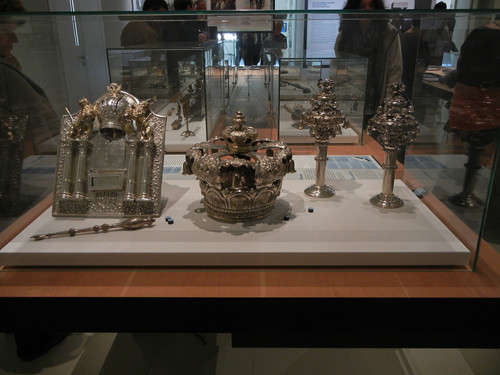
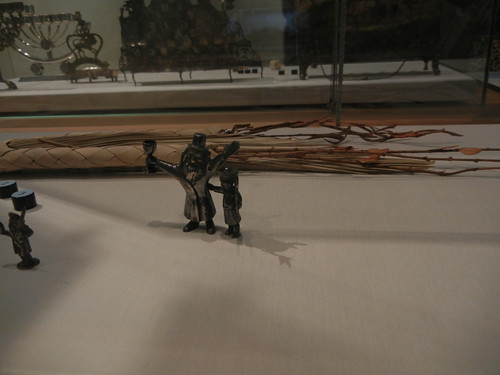
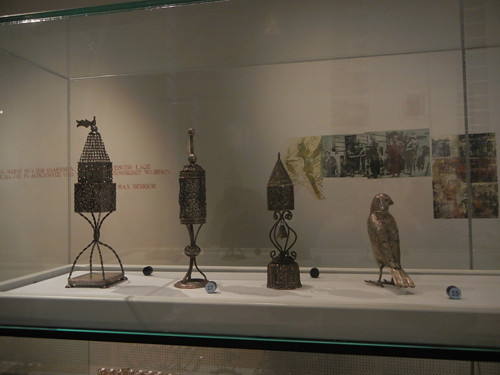

This museum visit was unforgettable; however, in this modern interior, one couldn't help but feeling that the history recorded there were somewhat pale and less vivid, and more manicured. For a more down to earth experience of ancient and contemporary Jewish life, my trip to the Jewish Ghetto in Venice two weeks later provided the answer and I'll report it soon, hopefully.
Related posts on Art · 文化 · Kunst:
- Il Ghetto di Venezia and Museo Ebraico (Jewish Museum) in Venice
- Gustav Klimt and Egon Schiele in Wien (Vienna)
- Theater Experiences in Wien (Vienna)
- Magnificent Churches in Vienna
Label: Austria, Austria and Italy Trip 2012
Labels:
Austria,
Austria and Italy Trip 2012,
Jewish Museum,
Jüdisches Museum,
Museum,
Vienna,
Wien
Subscribe to:
Comments (Atom)

